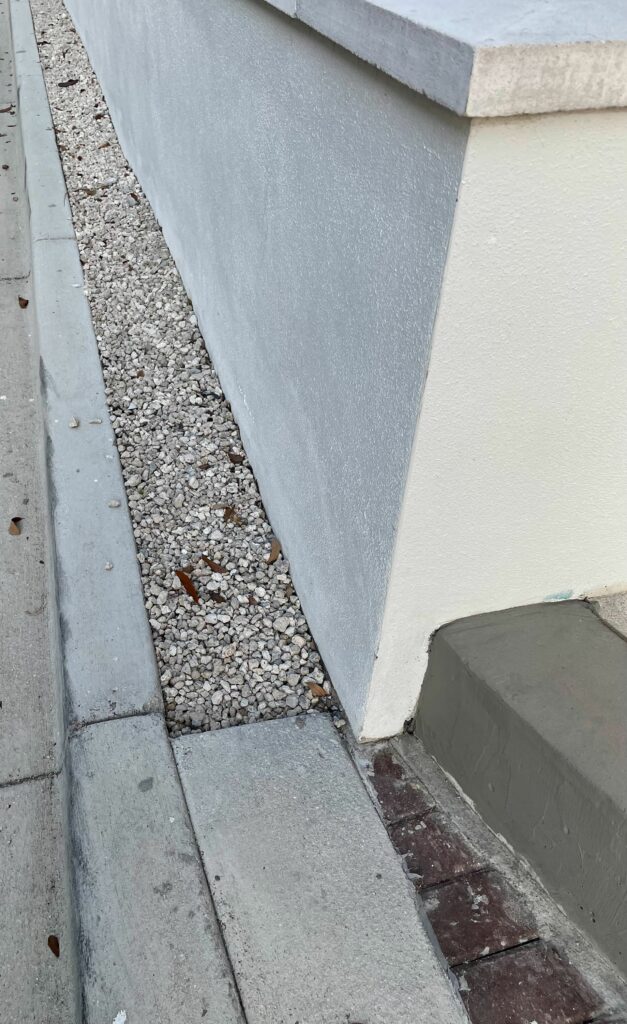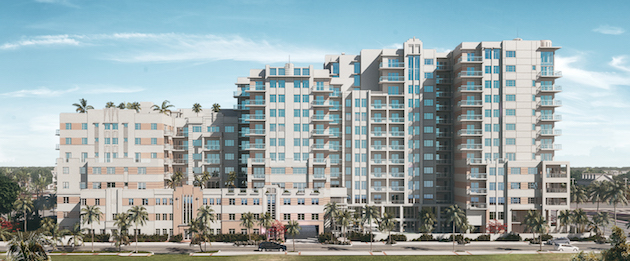Boca Raton has a requirement that all buildings have open space. It is an admirable idea, but since 2016, developers and architects have taken advantage of loopholes that maximize profit at the expense of public enjoyment. Architects could use open space to give pedestrians a break from concrete walls and concrete canyons. But unfortunately, Boca’s architects have subverted the nuances of the code and used hidden space from obscure places in their designs and counted it as open space.
The Aletto at Sanborn Square: Case in Point
One such project currently proposed is The Aletto at Sanborn Square. It consists of three large buildings on a small 1.3 acre parcel across from Sanborn Square on NE 1st Ave. If Aletto is approved, your view from the park will be a 12 story apartment building 155-feet tall.

There will also be a 7-floor office building on Palmetto Park Rd and an 8-floor (with two additional underground) unproven automatic garage for 365 cars (175 short from what’s required), on narrow East Boca Raton Road. Below is the developer’s rendering of what Aletto would look like. Somewhere in all that concrete is much of the project’s so-called open space. Sanborn Park, by the way, is on the middle left, dwarfed by the buildings.

Aletto Square: Deja Vu All Over Again
Make no mistake about it. This is a huge building brought to you from the same architect and developer that stuffed Tower 155 into a postage-stamp sized lot. The problems with Aletto’s density, the garage, traffic, and parking are so immense that a separate article is needed. But for example, the project averages 255,000 square feet of building space per acre. This is the equivalent of putting seven sets of Aletto buildings in the Camino Square parcel (where Wynn Dixie used to be).
Aletto Square: The Open Space Flim Flam
But I digress, this article is about “Open Space”. While Aletto abides by the city’s open space code, it’s far from something that serves the public interest. The problem is the difference between the technical requirements in square feet versus the reason for having open space in the first place, to provide space of visual interest to pedestrians and a break from the hard edge of construction. Architects and developers, however, are only interested in one thing — meeting the minimum requirements.
According to the code, the amount of open space depends on building height. For buildings over 75 feet tall, 40% of the lot size must be open space. But all is not what it seems. What you expect to see with that 40% (a little more than a half-acre of space) is nothing like the open space that is actually there. In fact, some of Aletto’s ”open space” is at the bottom of the parking garage with a rooftop swimming pool far above.
If I stand on a balcony and look east, then squint my eyes during the right time of day, I can just about see a very tiny patch of the ocean. To a developer this “feature” would be called an ocean view. The same with open space.
Open space, as defined by the code, is “open from the land to the sky predominantly designed for and paved with bricks, pavers or other similar material for pedestrian use, or an area where no structures, or buildings other than landscape features, fountains, benches, arcades and objects of art are located.”
Open space around commercial buildings is meant to enhance the public experience, so pedestrians supposedly won’t be overwhelmed by tall concrete monoliths. It’s to make walking a more pleasurable experience, with public art, landscaping, and architectural elements. And, it’s to bring open space into the public realm.
Back in 2016, as reported by the Coastal Star and Sun Sentinel, local architects met with city officials to discuss rules for open space. When it was suggested that open space be predominantly in front of the building, the architects opposed the idea because it might “limit their design possibilities.” Scott Singer, the chairman of the CRA at that time, felt the intentions should be that open space “be predominantly visible [to the public] and connect to the public realm.” The idea was to have open space that residents and visitors can see as they walk or drive downtown, even if they don’t have access to it. Later that year, the city adopted updated policy that requires open space areas to be “predominately visible from and connected to the public realm.”
But there are a few small caveats. Open space does not equal green space. Quite the contrary. In downtown, open space will most likely be brick, pavers, or concrete surfaces for walking on.
Second, the open space does not have to be one large open area. It can be divided up around the property. A few feet here, a few feet there, as long as they add up to the required amount. For instance, according to the code, this one foot space between the curb and the wall of Tower 155 is open space.

Boca’s Open Space Oxymoron: Open Space Does not have to be Open
The city allows up to 35% of the open space requirement to be “covered open space.” Certainly an oxymoron, but covered open space can be under things like arcades, colonnades, exposed balconies, exposed stairwells, canopies, and areas under pedestrian bridges. So underneath an open balcony, instead of seeing the clouds and birds flying, you see the underside of the balcony, but it is still considered “open space”.
Finally, in spite of the city policy to be “predominately visible from and connected to the public realm”, Boca city code allows open space to not be public space. Open space around a single-family home, for example, is not open to the public. The same goes for space around office and other commercial buildings. But even if not public, it must, as Scott Singer said, be predominantly visible and connect to the public realm.
Below is the open space plan for the proposed Aletto Square.

The large white area in the lower left corner is an existing building that the developer (thankfully) could not acquire. It contains small stores and businesses, such as the Sanborn Café which may be in jeopardy due to the prolonged construction period next door if Aletto is approved.
The areas in green represent “open space”. Although it’s shown as green in the site plan, it’s actually pavers, bricks, or concrete. It IS NOT GRASS around or between buildings. And, the “open space” section on NE 1st Ave and East Palmetto Park Road is only a slightly widened sidewalk. If you look closely at the layout, you’ll see spaces marked TX on either side of the office building. These are rooms that hold electrical transformers and equipment. For some reason, these are also in green to indicate open space, but I can’t imagine how they enter into the public realm.
Next, you have the areas in yellow which is “covered open space”. Lastly, you have the white area on the upper right which is the driveway that encircles the parking lot. The total “open space” and “covered open space” areas are combined to make up at least 40% of the land mass.
Plan Versus Reality
It may be difficult to really picture open space from these diagrams. So to use an existing building as an example, here is the original open space plan for Tower 155. Since it was originally submitted, the area circled on the right has been removed and what looks like two buildings have been combined. We are using this plan because the coloring makes it easier to visualize,

Looks like quite a lot of open space. But the actual building looks like what’s shown in the picture. It’s hard to see the almost 42% of mysterious open space.

An Embarrassment to the City
In the Aletto plan, remember that the green areas are not grass. Much of the open space area is not visible to pedestrians walking past, but is in the interior of the project or between buildings. Notice that they include the small islands and walkways that are actually within the garage but considered covered open spaces. How those can be considered open space when far above is a swimming pool on the roof, not the sky, is just beyond belief. There is nothing open about it. Required open spaces are meant to enhance and improve the public realm. It is hard to imagine how these small sections inside and at the bottom of a parking garage actually accomplish that and can be considered open space of any kind. No pedestrian will look into that garage and think “what a beautiful open space.”
For a city that prides itself for its parks, acceptance of this open space plan would just be an embarrassment.

The largest open space in this project is an interior courtyard between the parking lot and the office building. It is a nice space that leads to the entrance to the office building, but cannot be seen by pedestrians walking by. If you are walking on East Boca Raton Road, you would have to look through the garage to get a glimpse of it. If you were walking on East Palmetto Park Road, you might not see it at all.
If you’ve spent any time in and around Sanborn Square, your idea of open space is not reflected here. A patch here and a patch there. A couple feet of pavers next to a wall. When you view the project from within the park, or walk past, you won’t really see much of the open space. This is what you’ll see facing looking East from the park. A 12-story building.

While it might satisfy the open space requirements of the city, it does not reflect the intent of the code and the expectations residents might have of open space. From this example, it is obvious that if Boca Raton is serious about open space, it needs to further review and refine the code to put some brakes on irresponsible runaway development.
The Aletto at Sanborn Square is just too big for its location. It doesn’t fit in with the low buildings and open space of Sanborn Square. It is unsightly and poorly planned. The lack of adequate parking, the ludicrous open space plan, the traffic it will bring to the small streets in the area, will just be devastating to the entire downtown. It smashes as much billable space as they believe possible into a small area. Let’s hope that the City sees that as an impossible.

